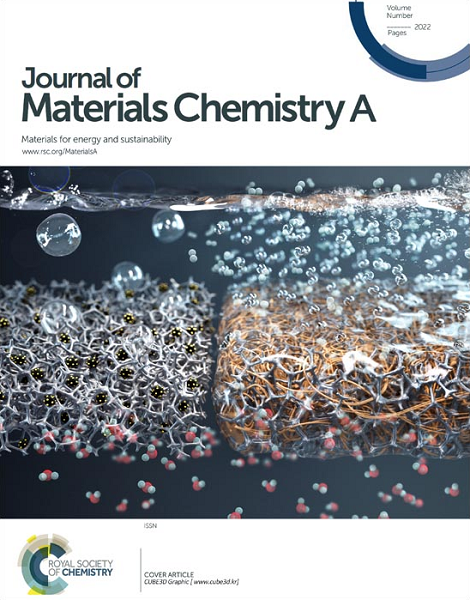一种异向结晶和掺氮的 CuWO4 光阳极,用于高效、稳健的可见光驱动水氧化
IF 10.7
2区 材料科学
Q1 CHEMISTRY, PHYSICAL
引用次数: 0
摘要
通过混合金属-咪唑浇注(MiMIC)法与 1-丁基咪唑(BIm)合成了用于光电化学(PEC)水氧化的氮掺杂 CuWO4(N-CuWO4)光阳极。由于掺入了 N,N-CuWO4 电极在波长为 540 nm 的长波长上的 PEC 水氧化能力比未掺入 BIm 的薄膜(纯 CuWO4)提高了 40 nm。N-CuWO4 表面紧密地覆盖着直径为 100-500 nm 的蠕虫状颗粒,这是 N-CuWO4 薄膜牢固地附着在基底上的原因。N-CuWO4 薄膜显示出三菱形 CuWO4 的各向异性结晶,主要向 [010] 和 [100] 方向生长,这与纯 CuWO4 薄膜的各向同性结晶形成鲜明对比。N-CuWO4 电极在 PEC 水氧化方面表现出卓越的性能,入射光子到电子的转换效率(IPCE)为 5.6%,其中电荷分离效率(ηsep)为 12.3%,催化效率(ηcat)为 51.9%(420 纳米和 1.23 V 时),O2 演化的法拉第效率(FEO2)为 97%,并且在 40 小时内具有显著的稳定性。N-CuWO4 电极表面的水氧化速率常数(kO2 = 1.6 × 102 s-1)比纯 CuWO4 电极的水氧化速率常数(6.8 s-1)高出 2 个数量级,这也是 N-CuWO4 电极具有高 IPCE 和 ηcat 的原因。N-CuWO4 电极较高的 kO2 可归因于表面 (100) 面上较高的水氧化活性位点。本文章由计算机程序翻译,如有差异,请以英文原文为准。
An anisotropically crystallized and nitrogen-doped CuWO4 photoanode for efficient and robust visible-light-driven water oxidation
A nitrogen-doped CuWO4 (N-CuWO4) photoanode for photoelectrochemical (PEC) water oxidation was synthesized by a mixed metal-imidazole casting (MiMIC) method with 1-butylimidazole (BIm). The N-CuWO4 electrode attained PEC water oxidation at the longer wavelength of 540 nm by 40 nm compared to the film (neat-CuWO4) prepared without BIm due to the N-doping, which was conscientiously characterized by spectroscopic and theoretical investigations. The N-CuWO4 surface was compactly covered with worm-like particles of 100-500 nm in diameter, which is responsible for the N-CuWO4 film adhering rigidly on the substrate. The N-CuWO4 film showed anisotropic crystallization of triclinic CuWO4 with predominant growth to [010] and [100] directions, in contrast to isotropic crystallization for the neat-CuWO4 film. The N-CuWO4 electrode demonstrated the superior performance for PEC water oxidation with incident photon-to-electron conversion efficiency (IPCE) of 5.6% contributed from charge separation efficiency (ηsep) of 12.3% and catalytic efficiency (ηcat) of 51.9% (at 420 nm and 1.23 V), Faraday efficiency (FEO2) of 97% for O2 evolution, and significant stability for 40 h, which compares advantageously with those for the state-of-the-art CuWO4-based photoanodes. The water oxidation rate constant (kO2 = 1.6 × 102 s-1) at the surface for the N-CuWO4 electrode was higher than that (6.8 s-1) for the neat-CuWO4 electrode by 2 orders of magnitude, which is responsible for the high IPCE and ηcat for the N-CuWO4 electrode. The higher kO2 for the N-CuWO4 electrode is ascribable to the higher active site on the (100) facet for water oxidation at the surface.
求助全文
通过发布文献求助,成功后即可免费获取论文全文。
去求助
来源期刊

Journal of Materials Chemistry A
CHEMISTRY, PHYSICAL-ENERGY & FUELS
CiteScore
19.50
自引率
5.00%
发文量
1892
审稿时长
1.5 months
期刊介绍:
The Journal of Materials Chemistry A, B & C covers a wide range of high-quality studies in the field of materials chemistry, with each section focusing on specific applications of the materials studied. Journal of Materials Chemistry A emphasizes applications in energy and sustainability, including topics such as artificial photosynthesis, batteries, and fuel cells. Journal of Materials Chemistry B focuses on applications in biology and medicine, while Journal of Materials Chemistry C covers applications in optical, magnetic, and electronic devices. Example topic areas within the scope of Journal of Materials Chemistry A include catalysis, green/sustainable materials, sensors, and water treatment, among others.
 求助内容:
求助内容: 应助结果提醒方式:
应助结果提醒方式:


